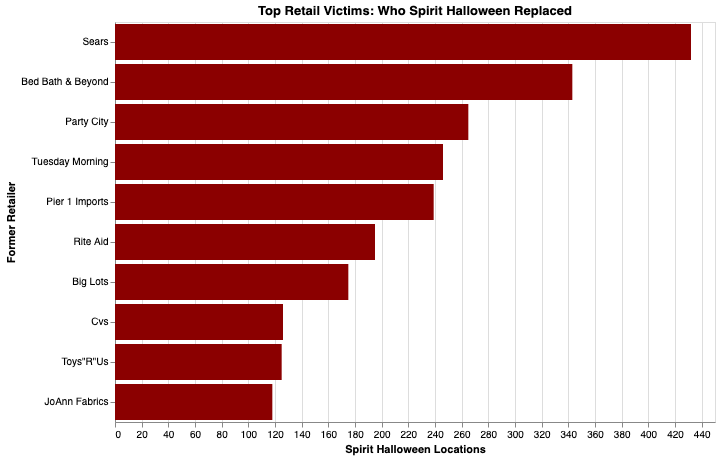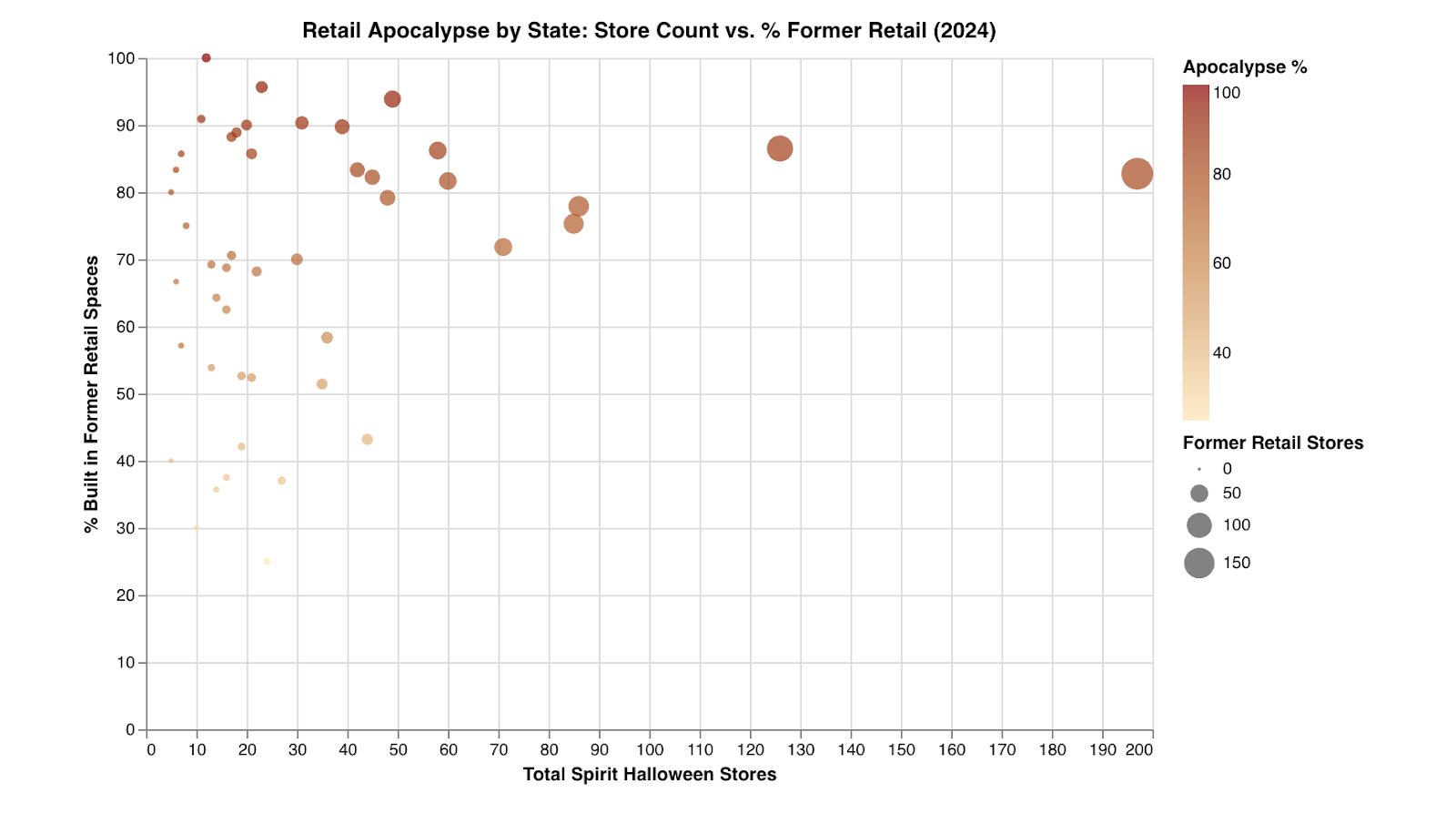
Happy fall, and welcome to the Halloween season! For today’s dive into American commerce, we’re looking at how seasonal pop-up stores have become a kind of zombie feeding on dead real estate. Every autumn, this dark ritual unfolds across American strip malls. Orange and black banners appear overnight in vacant storefronts. Skeletons and witches materialize in windows that have been pitch dark for months. Halloween stores have arrived, ready to profit from retail's slow-motion collapse.
Our analysis of six years of Spirit Halloween location data (2019-2025) shows a sophisticated operation that has turned so many retail failures across the country into a business model that works exceptionally well for a few months a year. The numbers tell a story of strategic opportunism: 78% of recent Spirit Halloween stores are located in former retail spaces, transforming the corpses of bankrupt chains into a multi-hundred-million-dollar seasonal empire.
Enigma has peered into an unholy dataset revealing the dark economics of retail necromancy, measured in square footage and failed leases, told through the lens of the country's most successful Halloween pop-up chain.
Spirit Halloween has grown dramatically over the past six years, expanding from a few hundred seasonal locations to a network of over 1,400 stores by 2024. But the real story isn’t growth — it’s how they’re growing. Unlike traditional retailers building new infrastructure, Spirit Halloween has mastered the art of opportunistic real estate acquisition.
The pattern is unmistakable: Spirit Halloween scouts for recently-closed retail locations with the right square footage, secures a short-term lease at distressed rates, and transforms the space within weeks. They’re not competing in the retail real estate market, but rather reanimating necrotic storefronts as an undead legion of commerce.
They’re not alone in this space — at least not yet. Halloween City, once Spirit Halloween's primary competitor, operated 254 stores at its peak in 2019. By 2024, Halloween City had completely disappeared. The data shows a brutal consolidation: as Spirit Halloween expanded, Halloween City contracted at an almost identical rate. Falling from 254 stores to zero in just four years, Halloween City’s demise tells its own story about the winner-take-all dynamics of seasonal retail.

Look at the names on Spirit Halloween's real estate portfolio and you're reading a roll call of retail failures. Sears and Bed Bath & Beyond lead the list, with hundreds of former locations that are now Spirit Halloween stores. Former Toys “R” Us locations, once massive commercial destinations for families, now sell animatronic zombies instead of action figures. Party City, itself struggling with bankruptcy, has seen multiple locations flipped to its seasonal competitor.
The top victims tell a familiar story: they are big-box retailers that couldn’t adapt to e-commerce, specialty stores that lost relevance, and chain restaurants that overexpanded. Our analysis of 2023-2025 Spirit Halloween locations reveals they’ve absorbed space once inhabited by at least 50 different retail chains.

Some brands appear repeatedly: multiple former Kmart locations (themselves victims of an earlier retail apocalypse), numerous defunct Sports Authority stores, and a surprising number of former supermarkets that couldn’t compete with Walmart and Amazon’s entry into the grocery store market. Each represents not just a failed business, but a failed bet on consumer behavior, physical retail, or simple overexpansion.
The economics are brutal but simple: Spirit Halloween pays a fraction of what these spaces once commanded for year-round leases, often securing three-month deals at deeply distressed rates. Landlords accept these terms because vacant properties generate zero revenue, create maintenance liabilities, and signal distress to other tenants. Spirit Halloween’s arrival turns a liability into a modicum of cash flow, even if it’s only temporary.
Spirit Halloween doesn’t just expand—it constantly optimizes its portfolio of locations. Using store tracking data across multiple years, Enigma can measure exactly what happens when Spirit Halloween closes a location and opens a new one nearby. The patterns reveal sophisticated real estate strategy. A full 25% of Spirit Halloween closures aren’t really closures at all — they’re relocations within the same shopping center, literally moving from one dead retailer to a neighboring one. Another 47% are local optimizations, moving within 5 miles to upgrade to superior locations as better retail corpses become available.
The median migration distance is just 1.7 miles, showing that Spirit Halloween rarely abandons a market entirely. Instead, they're constantly trading up, moving from adequate spaces to ever more optimal ones as ongoing retail failures create new opportunities. According to our data, only 3% of store movements represent true market exits.
This reveals something important: Spirit Halloween isn’t just passively filling vacant retail. They're actively curating a portfolio, abandoning less desirable locations as soon as better options appear. This amounts to retail real estate arbitrage, executed at scale, with the holiday calendar providing ample time to maneuver for these annual location shuffles.
The retail apocalypse isn’t uniformly distributed, and neither is Spirit Halloween. Our state-level analysis reveals where retail consolidation hits hardest. States with the highest concentration of Spirit Halloween stores in former retail spaces — often exceeding 80% — tend to be those that saw the most aggressive big-box retail expansion during the 1990s and 2000s, followed by the sharpest contractions in the 2010s.

California and Texas lead in absolute store count with 100+ Spirit Halloween locations, but the percentage of those in former retail spaces varies dramatically by market. Urban markets with diverse retail ecosystems show lower percentages, while suburban markets that were heavily dependent on now-defunct chains show the highest rates of retail repurposing.
And the pattern isn’t random. Spirit Halloween concentrates in middle-income suburban areas — precisely the markets that supported the big-box retail explosion of the 1990s and now suffer most from its collapse. These are communities built around car-dependent shopping centers, where retail square footage far exceeds sustainable demand in an e-commerce era.
Spirit Halloween’s business model is both brilliant and deeply revealing of the American retail landscape. By operating only during the most profitable season and leveraging distressed real estate, they’ve found a way to profit from what defeats others: the overcapacity and declining foot traffic that plague year-round retailers.
But Spirit Halloween isn’t causing the retail apocalypse. In a way, they’re documenting this collapse with their shifting nationwide footprint. Every new store location is a marker of retail failure, a data point in the ongoing transformation of American commercial real estate. The 1,400+ Spirit Halloween stores operating in 2024 represent so many stories of overexpansion, changing consumer behavior, and the brutal economics of physical retail in an Amazon-dominated world.
The important question is what happens next. Spirit Halloween can only expand as long as retail keeps failing. If American retail ever stabilizes — that is, if the pace of store closure slows — Spirit Halloween’s growth model would also face fundamental limits.
For now, though, the retail apocalypse continues, and every October, Spirit Halloween returns to remind us exactly which retailers didn’t survive another year. The skeletons in those windows aren’t just Halloween decorations — they're the lingering ghosts of American retail.
For the nerds: follow along with Enigma’s data analysis for this article.
https://newsletter-interactive-2025-10-spirit-halloween-ff54de.gitlab.io/